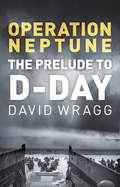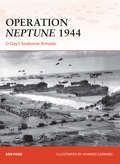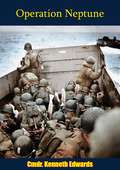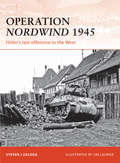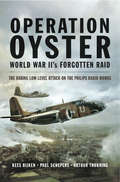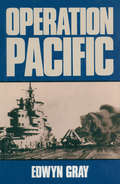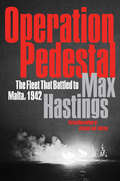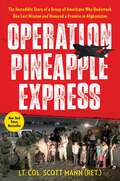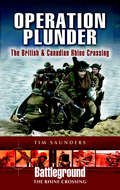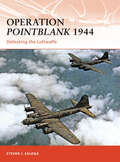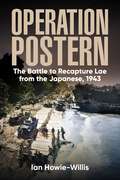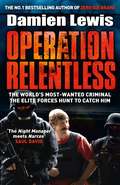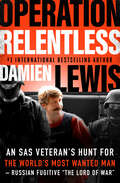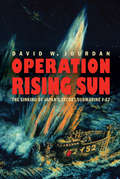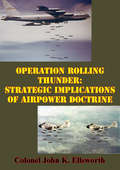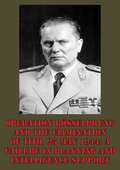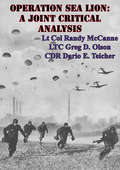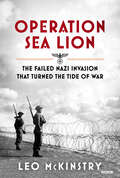- Table View
- List View
Operation Neptune: The Prelude to D-Day
by David WraggLong-awaited, the Normandy landings were the largest amphibious operation in history. Success was achieved by the advent of specialised landing craft, heavy naval firepower and the creation of two artificial harbours and an underwater pipeline. Operation Neptune: The Prelude to D-Day tells the story of this incredible feat using eyewitness accounts of the landings and the breaching of Hitler’s famed ‘Atlantic Wall’.David Wragg explores the earlier Allied and Axis experiences with amphibious operations and the planning for Neptune and Overlord. He reveals the naval support needed once the armies were ashore and before continental ports could be captured and cleared of mines, with operations such as minesweeping off the Normandy coast, which led to one of the worst ‘friendly fire’ incidents of the war. This is the must-read book to understand what made D-Day possible.
Operation Neptune 1944
by Ken FordJune 6th, 1944: the largest fleet in history landed Eisenhower's Allied army on the beaches of Normandy against Erwin Rommel's Nazi German defenses. Almost seventy years on from D Day, the story of the greatest armada seen in world history is still not widely known. It has been celebrated in only two major books, both titled Operation Neptune; the first was published just after the war in 1946, the second in 1974, although reprinted in a new edition in 2008. Both were full of details, but lacked visual appeal. With the forthcoming anniversary of D Day in 2014, the time is right for the story to be told again in the style of the Campaign series.Operation Neptune was the greatest naval operation ever undertaken, especially if looked at from the number of ships employed in the venture - over 7,000. This incredible enterprise is now completely overshadowed by the lan combat aspects of the invasion. When people think of D Day, they think primarily of troops storming the beaches and fighting their way inland. How these troops got to the beaches; how the seaward flanks of German defences were bombarded by accurate gunfire; how the fighting men were reinforced; how their casualties were evacuated back to England and how the later divisions were organised, transported and disembarked seems not to have been part of the public narrative of the invasion. It is now time that the work of planners, shipbuilders, logistic experts, and the men of the Royal and US Navies, and their allies, was shown to a modern audience.The planners of Operation Neptune were charged with returning Allied forces in strength to mainland Europe. Whilst the land aspects of the operation were left to the generals, the admirals had to ponder how the troops and their equipment could be transferred safely from quiet harbours in Britain on to a very hostile shore. The task required of them was immense. They had to find enough suitable mutually supporting beaches and assemble sufficient shipping to transport troops across the Channel. They also had to organise protection for the ships on passage and the bombardment of enemy defences covering the landing places. Landing craft had to prepared and crews trained to deliver the troops on time, in place and in correct order, then to introduce follow-up troops to a tight timetable and evacuate the wounded. Even more ships had to be found to re-supply those troops ashore. Then, when the assault phase was over, the US and Royal navies had to continue to support the enlargement of the lodgement with large calibre guns whilst their engineers built new artificial harbours and performed a host of other unspecified objects too numerous to mention. Operation Neptune was absolutely immense in its scope.In addition to the naval aspects of the operation other great feats of engineering were also undertaken. Artificial harbours, a 60 mile fuel pipe line under the ocean, artificial breakwaters and other engineering marvels made D-Day a supportable reality.The story of Operation Neptune was, of course, more than just a tale of planning, building and logistics. It had action a-plenty and the emotive tales of bravery, ingenuity and determination by the crews of the ships involved brought credit to the naval traditions of the Allied nations. Battleships, cruisers and destroyers bombarded enemy positions; midget submarines pointed the way to the beaches; minesweepers worked secretly by night to clear lanes; landing craft of all sizes braved enemy fire and mines to deposit their loads on the beaches and naval beach parties endured shellfire and machine guns to bring order to the beaches. Royal Navy commandos and US naval engineers dealt with beach obstacles against rising tides in the face of withering enemy fire.
Operation Neptune [Illustrated Edition]
by Cmdr. Kenneth Edwards'Operation Neptune' was the codename for the naval component of the invasion of France in June 1944. The complete invasion codename was 'Operation Overlord', and 'Neptune' was phase one of a much bigger plan. Nevertheless, the task of safely landing 160,000 men with all of the supporting equipment was an operation on an unprecedented scale.The operation, planned by a team under Lieutenant-General Frederick Morgan, was the largest amphibious invasion in world history and was executed by land, sea, and air elements under direct British command with over 160,000 troops landing on 6 June 1944. Of these, 73,000 were American troops, 61,715 British and 21,400 Canadian.To achieve the successful landings, 195,700 Allied naval and merchant navy personnel in over 5,000 ships were involved. The invasion required the transport of soldiers and material from England by troop-laden aircraft and ships, the assault landings, air support, naval interdiction of the English Channel and naval fire-support. The landings took place along a 50-mile stretch of the Normandy coast divided into five sectors: Utah, Omaha, Gold, Juno, and Sword.The planning required for such a mammoth undertaking was vast, and all to be maintained under the strictest secrecy. The fact that the Germans were caught by surprise is incredible, and a great debt of gratitude is owed to the men and women who worked so hard to bring off the greatest sea-borne invasion in history.This book, written only one year after the invasion by a senior British naval officer who was closely involved, provides the detail behind the conception, planning and successful execution of 'Neptune'. Richly illustrated throughout.
Operation Nightmare: The Story of America’s Betrayal in Korea and the United Nations
by Frank Cunningham Pat BarhamPat Barham sensed a huge opportunity and jumped at the chance to be assigned to become one of the first war correspondents to report on the Korean War. She knew that she would face many difficulties taking the post, not least of which was that she would be a woman in a very deadly man’s world. She reported back as the eyes and ears of the Hearst corporation and was shocked by the lack of support for the troops that she met on the frontline from Stateside audiences. In this book she records her tumultuous adventures and encounters in Korea among the American and Republic of Korean troops during the seemingly “forgotten war”.
Operation Nordwind 1945: Hitler's last offensive in the West
by Jim Laurier Steven ZalogaOperation Nordwind is one of the lesser known campaigns of World War II (1939-1945), yet one of the more intriguing. Largely overshadowed by the Battle of the Bulge further north, Nordwind was the last great operation by the Waffen-SS Panzer divisions in the west, and the last time the Wehrmacht was on the offensive in the West. The campaign also highlights the difficulties of inter-Allied cooperation between the Americans and the French. This campaign has been extensively treated in German and French accounts, but is not well covered in English.
Operation Overflight: The U-2 Spy Pilot Tells His Story for The First Time
by Francis Gary Powers Curt GentryFor the first time since his release from a Russian prison in 1962, pilot Francis Gary Powers reveals the full story of the most sensational espionage case in Cold War history: the U-2 incident.
Operation Overlord, Design And Reality; The Allied Invasion Of Europe: The Allied Invasion Of Western Europe
by Dr Albert NormanA fascinating in-depth study of the planning for the D-Day landings which set the first Allied troops on the road to Berlin. Dr Norman served with the US 12th Army Group staff during the Second World War under General Omar Bradley, which put him in an expert position to tell the story of the exhaustive preparations that went into the Normandy invasion on 6th June 1944.‘“Overlord” was unquestionably, as of this writing, the largest overseas military operation ever undertaken. In the pages which follow, Dr. Albert Norman presents, insofar as it can be compressed within one easily readable volume, a careful history of the planning which made its achievement possible and of the operation itself.Dr. Norman’s topic is absorbing, both for its historical interest and for the lessons it holds for those who, perhaps unfortunately, must be concerned with the possibility of “Overlords” yet to come. It holds yet another and even more important interest. The staff groups which contributed to the success of “Overlord” and the ultimate defeat of Germany were the exemplification of an idea of allied unity, developed by General Eisenhower and perfected to such an extent that it has become the symbol of successful international cooperation.’—General Walter Bedell Smith
Operation Oyster World War II's Forgotten Raid: The Daring Low Level Attack on the Philips Radio Works
by Kees Rijken Paul Schepers Arthur G. ThorningOperation Oyster was carried out on the 6th December, 1942 by 2 Group RAF. Considered to be a notable success for the allies, it cost the Germans an estimated six months of lost production time at a critical point in the conflict. It is arguable, according to the authors, that the operation was in fact rather more significant than Operation Chastise, the Dambuster raid, while accepting that was a remarkable feat of arms. Operation Oyster struck at the very heart of what Churchill termed 'the wizard war' against German radio navigational technology by attacking a central hub of activity; the Philips Radio Works in Eindhoven, The Netherlands. The development of electronics in WWII was the most significant technical aspect of weaponry over the course of the conflict. On both sides, there were great advances in radar and communications which, at that time, depended on the wide- scale use of high frequency radio valves few companies had the technology to produce these, but the leading one in Europe was Philips in Eindhoven. Thus it was determined that Philips was the most important target. Ninety-three allied aircraft took part and a total of fourteen were lost. But the result in terms of damages to the enemy was considerable, hindering the German war effort significantly and consequently aiding the allies. Despite these facts however, the story of the raid has been underreported, and the efforts of the aircrew who took part have been little recognized. By comparison, the Dambuster raid which came six months later has entered into folklore. Here, for the first time, the overlooked Oyster raid is afforded the attention it deserves.
Operation Pacific: The Royal Navy's War Against Japan 1937-1945
by Edwyn GrayA history of the United Kingdom&’s contribution to the Pacific theater of the Second World War, by the author of Disasters of the Deep. Hollywood&’s version of the World War II in the Pacific has led many people to believe that it was an all-American affair, and that Britain took no part in it. But, as Edwin Gray shows in Operation Pacific, that is false. The British Royal Navy and its Commonwealth partners played a very significant role in the Pacific War. They waged a vigorous, non-stop battle with the enemy from the earliest days to the ultimate triumph of victory. Japanese troops also landed in Malaya and opened hostilities in Britain a full ninety minutes before Nagumo&’s dive-bombers swept down on the unsuspecting American pacific Fleet at Pearl Harbor to bring the United States into the war.Operation Pacific is the first book to provide a full and detailed account of Britain&’s Naval contribution to the ultimate defeat of Japan, a saga that ranges from the darkest days of December, 1941, to the carrier operations and kamikaze attacks of the final battles in 1945. While in no way disparaging the heroic achievements and fighting courage of the U.S. forces in the Pacific, Edwyn Gray reveals that the Royal Navy&’s cooperation was not always welcomed by her over-mighty Ally, and that America&’s top brass—notably admiral Ernest King and General Douglas MacAuthur—were opposed to British involvement in the Pacific for both practical and political reasons. Operation Pacific is an absorbing story, offering a comprehensive picture of the part played by the Royal Navy and Commonwealth forces in the Far East War.
Operation Paperclip: The Secret Intelligence Program that Brought Nazi Scientists to America
by Annie JacobsenThe explosive story of America's secret post-WWII science programs, from the author of the New York Times bestseller Area 51In the chaos following World War II, the U.S. government faced many difficult decisions, including what to do with the Third Reich's scientific minds. These were the brains behind the Nazis' once-indomitable war machine. So began Operation Paperclip, a decades-long, covert project to bring Hitler's scientists and their families to the United States.Many of these men were accused of war crimes, and others had stood trial at Nuremberg; one was convicted of mass murder and slavery. They were also directly responsible for major advances in rocketry, medical treatments, and the U.S. space program. Was Operation Paperclip a moral outrage, or did it help America win the Cold War?Drawing on exclusive interviews with dozens of Paperclip family members, colleagues, and interrogators, and with access to German archival documents (including previously unseen papers made available by direct descendants of the Third Reich's ranking members), files obtained through the Freedom of Information Act, and dossiers discovered in government archives and at Harvard University, Annie Jacobsen follows more than a dozen German scientists through their postwar lives and into a startling, complex, nefarious, and jealously guarded government secret of the twentieth century.In this definitive, controversial look at one of America's most strategic, and disturbing, government programs, Jacobsen shows just how dark government can get in the name of national security.
Operation Pedestal: The Fleet That Battled to Malta, 1942
by Max HastingsRenowned historian Max Hastings recreates one of the most thrilling events of World War II: Operation Pedestal, the British action to save its troops from starvation on Malta—an action-packed tale of courage, fortitude, loss, and triumph against all odds.In 1940, Hitler had two choices when it came to the Mediterranean region: stay out, or commit sufficient forces to expel the British from the Middle East. Against his generals’ advice, the Fuhrer committed a major strategic blunder. He ordered the Wehrmacht to seize Crete, allowing the longtime British bastion of Malta to remain in Allied hands. Over the fall of 1941, the Royal Navy and RAF, aided by British intelligence, used the island to launch a punishing campaign against the Germans, sinking more than 75 percent of their supply ships destined for North Africa.But by spring 1942, the British lost their advantage. In April and May, the Luftwaffe dropped more bombs on Malta than London received in the blitz. A succession of British attempts to supply and reinforce the island by convoy during the spring and summer of 1942 failed. British submarines and surface warships were withdrawn, and the remaining forces were on the brink of starvation.Operation Pedestal chronicles the ensuing British mission to save those troops. Over twelve days in August, German and Italian forces faced off against British air and naval fleets in one of the fiercest battles of the war, while ships packed with supplies were painstakingly divided and dispersed. In the end only a handful of the Allied ships made it, most important among them the SS Ohio, carrying the much-needed fuel to the men on Malta.As Hastings makes clear, while the Germans claimed victory, it was the British who ultimately prevailed, for Malta remained a crucial asset that helped lead to the Nazis’ eventual defeat. While the Royal Navy never again attempted an operation on such scale, Hasting argues that without that August convoy the British on Malta would not have survived. In the cruel accountancy of war, the price was worth paying.
Operation Pineapple Express: The Incredible Story of a Group of Americans Who Undertook One Last Mission and Honored a Promise in Afghanistan
by Lt. Col. Scott MannINSTANT NEW YORK TIMES BESTSELLER An edge-of-your-seat thriller about a group of retired Green Berets who come together to save a former comrade—and 500 other Afghans—being targeted by the Taliban in the chaos of America&’s withdrawal from Afghanistan.In April 2021, an urgent call was placed from a Special Forces operator serving overseas. The message was clear: Get Nezam out of Afghanistan now. Nezam was part of the Afghan National Army&’s first group of American-trained commandos; he passed through Fort Bragg&’s legendary Q course and served alongside the US Special Forces for over a decade. But Afghanistan&’s government and army were on the edge of collapse, and Nezam was receiving threatening texts from the Taliban. The message reached Nezam&’s former commanding officer, retired Lt. Col. Scott Mann, who couldn&’t face the idea of losing another soldier in the long War on Terror. Immediately, he sends out an SOS to a group of Afghan vets (Navy SEALs, Green Berets, CIA officers, USAID advisors). They all answer the call for one last mission. Operating out of basements and garages, Task Force Pineapple organizes an escape route for Nezam and gets him into hiding in Taliban-controlled Kabul. After many tense days, he braves the enemy checkpoints and the crowds of thousands blocking the airport gates. He finally makes it through the wire and into the American-held airport thanks to the frantic efforts of the Pineapple express, a relentless Congressional aide, and a US embassy official. Nezam is safe, but calls are coming in from all directions requesting help for other Afghan soldiers, interpreters, and at-risk women and children. Task Force Pineapple widens its scope—and ends up rescuing 500 more Afghans from Kabul in the three chaotic days before the ISIS-K suicide bombing. Operation Pineapple Express is a thrilling, suspenseful tale of service and loyalty amidst the chaos of the US withdrawal from Afghanistan.
Operation Plunder: The British & Canadian Rhine Crossing (Battleground The Rhine Crossing)
by Tim SaundersThis WWII history and battlefield guide examines the Allied push across the Rhine with maps, photos, and informative text. By late March of 1945, the advance through Europe had brought Allied forces to Hitler&’s doorstep. Second British Army and Ninth US Army were poised to carry out an assault crossing of the Rhine. In the British part of the operations, Field Marshal Montgomery&’s best assault divisions were assembled to carry out the British and Canadian part of the attack between Emmerich and Wesel. A commando brigade and two Scottish divisions carried out the initial assault under cover of darkness and a tremendous bombardment on the evening of March 23rd. They fended off the German first Parachute Army, and by dawn they had established a bridgehead. During the following morning 6th British Airborne Division dropped around Hamminkeln, in the immediate rear of the Germans, in an operation codenamed VARSITY. By March 27th, after some heavy combat, the Allies were prepared to launch their final drive to the Baltic. The Rhine crossing, though by no means the final battle, sealed the fate of Nazi Germany. This comprehensive guide provides essential information on historic sites along with maps and photographs.
Operation Pointblank 1944
by Steven ZalogaOperation Pointblank was the code name for the United States Army Air Force's attempt to destroy German fighter capability through the use of daylight strategic bombing in advance of the D-Day landings. Launched in 1943, the operation immediately met with severe problems, most notably the horrible attrition experienced by the US bomber forces. However, with the arrival of the P-51 Mustang, the United States was able to equip the fighters to fly on long-range-bomber escort missions and take the fight to the Luftwaffe in the skies over Germany. This book examines the entire operation from both the Allied and the German perspectives, covering all the main decisions and technological innovations made by both sides in this epic struggle.From the Trade Paperback edition.
Operation Postern: The Battle to Recapture Lae from the Japanese, 1943
by Ian Howie-WillisJapanese troops seized and brutally occupied New Guinea&’s capital, Lae, for 18 months – until 16 September 1943. That day Australian soldiers retook the town against fierce resistance. Defeated, and after suffering huge losses, 8000 Japanese soldiers fled across the formidable 4000-metre mountains behind the town ; 2000 died on the nightmare trek.In a groundbreaking publication, independent professional historian Dr. Ian Howie-Willis unveils the untold story of 'Operation Postern' and its significant impact on the Pacific War. His latest book sheds light on the recapture of Lae, the capital of New Guinea, from Japanese forces on 16 September 1943. Through meticulous research, Dr. Howie-Willis brings to life the heroic efforts of Australian soldiers, the harrowing experiences of the Japanese retreat, and the often-overlooked plight of the Papua New Guinean village communities caught in the crossfire. Japanese troops had seized and ruthlessly occupied Lae for 18 months until the fateful day of the Australian soldiers' counteroffensive. Despite fierce resistance, the town was retaken, forcing the Japanese to retreat across treacherous 4000-meter mountains behind the area. Tragically, 2000 Japanese soldiers lost their lives during this nightmarish trek. Referred to as a turning point in the Pacific War, 'Operation Postern' shattered the Japanese belief that they could maintain control over the New Guinea mainland. Their continual retreat paved the way for subsequent successful Allied campaigns in the South-West Pacific theatre. However, victory came at a high cost, with over 2000 casualties within a fortnight for the Allies, while Japanese losses exceeded that number nearly fourfold. The exact toll on the Papua New Guinean village people remains unknown but undoubtedly significant. Dr. Howie-Willis challenges previous military histories that have marginalized the Papua New Guineans, highlighting their essential role as the "third party" to the conflict. By focusing on the village communities, he illuminates the horrific impact of the war on their lands and lives, offering a comprehensive and inclusive narrative. "Operation Postern" provides readers with an opportunity to revisit and reinterpret this crucial battle that shaped the course of history. Dr. Howie-Willis' extensive knowledge and meticulous attention to detail make this book a valuable contribution to the understanding of the Pacific War.
Operation Rafe's Redemption (Cutter's Code #17)
by Justine DavisTo bring down a traitor…She needs the man who betrayed her love!Years ago, Foxworth Foundation operatives walked into a trap that almost annihilated them all. So when Charlie Foxworth—the firm&’s cool financial mastermind—finds the man responsible, she&’ll stop at nothing to take him down. But to do it, she needs unflappable former sniper Rafe Crawford—the man who shattered her heart—plus K-9 Cutter. Little does she know, they also might be key to keeping her alive! From Harlequin Romantic Suspense: Danger. Passion. Drama.Read the Cutter's Code series from the beginning! Book 1: Operation Midnight Book 2: Operation Reunion Book 3: Operation Blind Date Book 4: Operation Unleashed Book 5: Operation Power Play Book 6: Operation Homecoming Book 7: Operation Soldier Next Door Book 8: Operation Alpha Book 9: Operation Notorious Book 10: Operation Hero's Watch Book 11: Operation Second Chance Book 12: Operation Mountain Recovery Book 13: Operation Whistleblower Book 14: Operation Payback Book 15: Operation Witness Protection Book 16: Operation Takedown Book 17: Operation Rafe's Redemption
Operation Relentless: The Hunt for the Richest, Deadliest Criminal in History
by Damien Lewis'The Night Manager meets Narcos' Saul David'To catch this criminal took incredible courage and skill. This is James Bond meets Jason Bourne' Bear GryllsThe new bestseller from the author of Zero Six BravoBy 2007 Viktor Bout had become the world's foremost arms dealer. Known as the 'Merchant of Death' he was both "Public Enemy No. 1" to the global intelligence agencies and a ruthless criminal worth around six billion dollars.For years Bout had eluded capture, meanwhile building up a labyrinthine network of airlines selling weapons to order to dictators, rebels, despots and terror groups worldwide. He was hunted by the CIA, NSA, MI6, as well sought by the United Nations for being their top global sanctions buster. Holed up in Moscow - from where he ran a suite of offices selling anything from AK47s to state-of-the-art helicopter gunships and anti-aircraft missiles - he was shielded by a Russian state that was a partner in his dark dealings. In short, Bout appeared utterly invulnerable and beyond any hope of capture. Step forward former SAS man Mike Snow. After serving in the Regiment, Snow had worked as a bush pilot in Africa, where he'd got to know Bout well. Via its own secretive, shadow network, Snow was approached by the US DEA, the Drugs Enforcement Agency. The DEA agents had one question for him: was Snow able to get to Viktor Bout? This is the incredible tale of OPERATION RELENTLESS, the top-secret mission that Snow and a handful of DEA operatives launched to entrap Viktor Bout - a story that ranges from the steamy jungles of Colombia to the ice-bound streets of Moscow, and from horrific bloodshed and tyranny in the Congo, to a snatch operation like no other. It may read like an implausible thriller, but every word of Operation Relentless is true.
Operation Relentless: The Hunt for the Richest, Deadliest Criminal in History
by Damien LewisFor years Bout had eluded capture, meanwhile building up a labyrinthine network of airlines selling weapons to order to dictators, rebels, despots and terror groups worldwide. He was hunted by the CIA, NSA, MI6, as well sought by the United Nations for being their top global sanctions buster. Holed up in Moscow - from where he ran a suite of offices selling anything from AK47s to state-of-the-art helicopter gunships and anti-aircraft missiles - he was shielded by a Russian state that was a partner in his dark dealings. In short, Bout appeared utterly invulnerable and beyond any hope of capture. Step forward former SAS man Mike Snow. After serving in the Regiment, Snow had worked as a bush pilot in Africa, where he'd got to know Bout well. Via its own secretive, shadow network, Snow was approached by the US DEA, the Drugs Enforcement Agency. The DEA agents had one question for him: was Snow able to get to Viktor Bout? This is the incredible tale of OPERATION RELENTLESS, the top-secret mission that Snow and a handful of DEA operatives launched to entrap Viktor Bout - a story that ranges from the steamy jungles of Colombia to the ice-bound streets of Moscow, and from horrific bloodshed and tyranny in the Congo, to a snatch operation like no other. It may read like an implausible thriller, but every word of Operation Relentless is true.
Operation Relentless: An SAS Veteran's Hunt for the World's Most Wanted Man—Russian Fugitive "The Lord of War"
by Damien LewisThe true story of the top-secret mission to capture the Russian billionaire arms dealer, the Merchant of Death: &“This is James Bond meets Jason Bourne&” (Bear Grylls, star of Man vs. Wild). Viktor Bout was the world&’s foremost arms dealer. From his hideout in Moscow, he masterminded the sale of weapons to dictators, rebels, despots, and terror groups worldwide—supplying anything from AK-47s to state-of-the-art helicopter gunships and anti-aircraft missiles. Known as the Merchant of Death, he was hunted by MI6, INTERPOL, the CIA, the NSA, and more. But the former KGB officer was shielded by a Russian state that partnered in his dark dealings. Evading capture for years, Bout appeared utterly invulnerable. Then elite forces veteran Mike Snow, AKA The Bear, stepped forward. Snow had gotten to know Bout while working as a bush pilot in war-torn Africa. When the Drug Enforcement Agency approached Snow through a secretive, shadow network, they had one question for him: could he ensnare the Merchant of Death? This is the real-life tale of Operation Relentless, the classified mission masterminded by Snow and a team of DEA operatives. Based on first-hand testimonies, it is the thrilling tale of a manhunt that ranges from the jungles of Colombia to the streets of Moscow, from horrific bloodshed and tyranny in Afghanistan to a snatch operation like no other.
Operation Rising Sun: The Sinking of Japan's Secret Submarine I-52
by David W. JourdanIn 1944 Allied codebreakers learned the Imperial Japanese Navy had dispatched the cargo submarine I-52 to occupied France with tons of military supplies and payment—in gold—for German assistance. I-52 undertook the mission as part of the Yanagi missions, a military program meant to alleviate Japan&’s desperate need for military material and technical knowledge. After tracking I-52 from Asia to the Atlantic, the Allies destroyed the vessel in a battle that ended the Yanagi missions and left I-52 an unlikely treasure ship on the seafloor. David W. Jourdan adds to the history of I-52 with a spellbinding account of his efforts to find the sunken submarine. One of the first joint American-Russian research expeditions, the search for the wreck combined a team effort, exhaustive detective work, and a dramatic battle with the sea. The effort paid off when the group found I-52&’s nearly intact hull three miles down. The expedition also earned an unexpected historical dividend when it uncovered one-of-a-kind recordings of American Avenger torpedo bomber attacks on an enemy submarine. Part war tale and part seagoing adventure, Operation Rising Sun tells the story of the two very different missions to find submarine I-52.
Operation Rolling Thunder: Strategic Implications Of Airpower Doctrine
by Colonel John K. EllsworthThis SRP examines Operation ROLLING THUNDER (1965-1968) bombing campaign in the context of military Principles of War and their applications. It analyzes accomplishment of strategic objectives and future implications for applications of airpower doctrine. It reviews the pre-Vietnam strategic situation, discussing its military, political, social, global, and doctrinal characteristics. It then analyses Operation ROLLING THUNDER by phases, focusing on its controversial aspects. This analysis concludes that Operation ROLLING THUNDER failed to accomplish most of its strategic objectives. It offers several contributing factors to account for this failure. This SRP concludes with examination of the lessons learned about airpower doctrine and of the strategic implications of Operation ROLLING THUNDER for the overall war effort in Vietnam.
Operation Rösselprung And The Elimination Of Tito, 25 May 1944: A Failure In Planning And Intelligence Support
by Lieutenant-Colonel Wayne D. EyreOperation RÖSSELPRUNG was a Second World War German operation conducted in Bosnia, which aimed at eliminating the leadership of the Partisan movement, namely Marshal Josip-Broz Tito. It was a direct action raid, which involved an airborne (parachute and glider) assault by 500 SS Fallschirmjäger (Parachute) Battalion on the suspected site of Tito's Headquarters and a subsequent linkup with the German XV Mountain Corps converging from all directions.Operation RÖSSELPRUNG failed due to mediocre intelligence support and inadequate tactical level planning. Intelligence shortfalls were rooted primarily in poor German inter-organization relations and cooperation, including the sharing of intelligence, which resulted in missed opportunities and a failure to pinpoint Tito's location with sufficient precision. Given the quality of intelligence provided, the plan for the airborne assault did not include sufficient flexibility for the execution of contingencies.There are three major conclusions from the failure of this operation that can be applied to contemporary operations of a similar nature:The first deals with tactics to be employed in the face of uncertain intelligence. The degree of intelligence certainty is critical in determining both the size of the force and the extent of the objective area in a direct action raid.The second is the requirement for contingency planning. Contingency planning provides commanders with flexibility once an operation has commenced to deal with the unexpected, and is especially vital in the face of uncertain intelligence.The third, and probably most critical, concerns the importance of interagency intelligence cooperation. It is vital that different intelligence organizations that are pursuing a similar goal, especially in the same theatre of operations, cooperate to the greatest extent possible.
Operation Schlosser (Eves Krieg, Heldinnen der Special Operations Executive #2)
by Hannah HoweEves Krieg ist eine Reihe aus zwölf Novellen. Jedes Buch ist circa 20.000 Wörter lang und beinhaltet eine in sich abgeschlossene Geschichte. Der Preis wird für die gesamte Reihe auf ein Minimum gesetzt. Der Handlungsbogen von Eves Geschichte wird am Ende der Reihe beendet. „Ich habe gehört, dass Sie nach Frankreich zurückkehren möchten“, sagte der Mann hinter dem Mahagoni-Schreibtisch. „Das ist korrekt“, bestätigte ich. „Und Ihre Beweggründe?“, fragte er und glättete die Spitzen seines Schnurrbarts. „Ich will meinen Teil zu den Kriegsanstrengungen beitragen“, erklärte ich, „die Nazis besiegen und herausfinden, was mit meinem Ehemann geschehen ist.“ „Es wäre äußerst riskant“, warnte der ernst aussehende Mann, „vielleicht sogar gleichbedeutend mit Selbstmord, als Frau solch ein Unterfangen allein anzugehen. Wir hätten da aber eine Alternative.“ „Eine Alternative?“ Ich runzelte die Stirn. „Ja. Wir bringen Sie dorthin, als eine von unseren Leuten. Natürlich müssten Sie zuerst eine Ausbildung absolvieren. Eine harte Ausbildung. Eine geheime Ausbildung. Wenn Sie versagen, bedeutet das leider eine Weile im Kühler, womöglich, bis der Krieg vorüber ist.“ „Im Kühler?“ „Aber ich bin sicher, so weit wird es nicht kommen“, fuhr er fort, ohne meine Frage zu beachten. „Wann können Sie beginnen?“ Ich begann sofort. Und während meiner Ausbildung traf ich zwei Leute, die mein Leben radikal verändern würden: Guy Samson und Mimi Duchamp. Ich lüftete auch Geheimnisse über mich selbst, Fähigkeiten, die meine Vorstellungskraft überstiegen. Aber während die Ausbildung voranschritt, wurden auch die Situationen immer realer, bis zu dem Punkt, an dem ich töten musste, um nicht getötet zu werden.
Operation Sea Lion: A Joint Critical Analysis
by Lt Col Randy McCanneMilitary history contains many lessons from which the warfighting doctrine of the individual services, as well as joint doctrine, is derived. World War II stands as one of the major contributors of valuable lessons learned. From a joint and combined warfighting perspective, Germany's planning and preparatory military actions to the invasion of Great Britain after the fall of France are instructive. Their plan, called Operation SEA LION by the Germans, was never carried out, as certain prerequisite conditions were never achieved, and Hitler elected to move on to other operations. But Germany could have been successful in invading and, if necessary, occupying Great Britain had they exercised joint and combined operations to achieve better unity of effort within the German military, remained focused on key British operational centers of gravity, and exploited the capabilities of friendly nations such as Spain, Italy, and the Vichy government of France.
Operation Sea Lion: The Failed Nazi Invasion That Turned the Tide of War
by Leo MckinstryIn the summer of 1940, the Nazi war machine was at its zenith. France, Denmark, Norway and the Low Countries were all under occupation. Only Britain stood in the way of the complete triumph, and Hitler planned a two-pronged offensive--a blistering aerial bombardment followed by a land invasion--to subdue his final enemy. But for the first time in the war, Hitler did not prevail.As Leo McKinstry details in this fascinating new history, the British were far more ruthless and proficient than is usually recognized. The brilliance of the RAF in the Battle of Britain was not an exception but part of a pattern of magnificent organization that thwarted Hitler's armies at every turn. Using a wealth of archival and primary source materials, Leo McKinstry provides a groundbreaking new assessment of the six fateful months in mid-1940 when Operation Sea Lion was all that stood between the Nazis and total victory.
